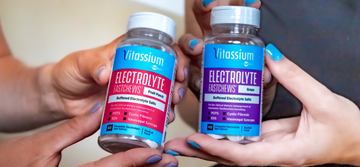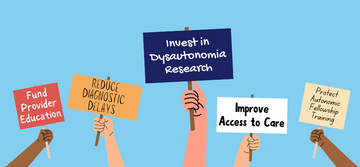
Did you know that there can be many underlying causes of Postural Orthostatic Tachycardia Syndrome (POTS)? The autonomic nervous system is frequently affected by the autoimmune disease Sjögren’s. In honor of April being Sjögren’s Awareness Month, we’re helping raise awareness for this autoimmune disorder and the awesome work of the Sjögren’s Foundation.
What is Sjögren’s?
Sjögren’s (“SHOW-grins” and may also be written as Sjogren’s) is a systemic autoimmune disease that affects the entire body. Along with symptoms of extensive dryness, other serious complications include profound fatigue, chronic pain, major organ involvement, neuropathies, and lymphomas. Sjögren's is often misrepresented as a rare disease, however it is estimated that there are four million Americans living with this disease, making it one of the most prevalent autoimmune diseases.
Nine out of 10 Sjögren’s patients are women. The average age of diagnosis is late 40s, although it can occur in all age groups, including children, and in both sexes.
Symptoms can vary from person to person and can stay stable or worsen over time. Some people have mild discomfort, while other people can suffer from severe and debilitating symptoms that can significantly impair functioning and impact quality of life. Some common symptoms can include:
- Dry mouth and/or dry eyes
- Difficulty swallowing
- Dry nose and/or sinus problems
- Fatigue
- Joint and muscle pain
- Swollen and/or painful parotid and salivary glands
- Gastrointestinal (GI) problems such as GERD, gastroparesis, irritable bowel symptoms, vomiting and diarrhea
- Recurrent bronchitis and/or pneumonia
- Autonomic nervous system problems such as tachycardia, blood pressure fluctuations, and orthostatic intolerance.
There isn’t one single progression of the disease, which can be challenging for physicians and frustrating for patients.
How is Sjögren’s Diagnosed?
People with Sjögren’s are often misdiagnosed or go undiagnosed. One reason is the symptoms of Sjögren’s often mimic those of drug side effects, allergies, and other medical conditions such as myalgic encephalomyelitis/chronic fatigue syndrome (ME/CFS), lupus and rheumatoid arthritis. The average time it takes patients to get a diagnosis is around three years.
Early diagnosis and proper individualized treatments are important because they may prevent serious disease complications and progression. There is no single test to confirm Sjögren’s. Instead, physicians ask a variety of questions about the patient’s symptoms and history and can perform a series of tests such as:
- Blood tests: SS-A (or Ro) and SS-B (or La) marker antibodies for Sjögren’s
- Schirmer eye test and other eye tests that measure tear production
- Salivary gland biopsy of the lower lip
- Salivary flow tests
What is the link between Sjögren’s and dysautonomia?
Sjögren’s can cause inflammation and damage to the central nervous system and peripheral nervous system, called neuropathy. It can also cause inflammation and damage to the autonomic nervous system, which regulates the coordination of heartbeat, respiration, and gastric motility, causing dysautonomia. Sjögren’s is the second most common cause of autonomic neuropathy, after diabetes, and has been associated with Postural Orthostatic Tachycardia Syndrome (POTS), Orthostatic Intolerance (OI), and other forms of dysautonomia. A study even found that 41% of patients with dysautonomia that had no known underlying cause who reported dry eyes and dry mouth had the antibodies found in the early stages of Sjögren’s.
Vitassium team member Natasha Graves was diagnosed with POTS as a teenager. Ultimately, it was discovered that the cause of her dysautonomia was Sjögren’s and she was officially diagnosed at 25 years old.
“Although my Sjögren’s was diagnosed much later than my POTS, I was lucky to find an underlying cause and that it was diagnosed at all because I am outside of what is considered the ‘typical’ age range for Sjögren’s. I have had so many doctors tell me that I am too young for Sjögren’s, which isn’t true. It doesn’t discriminate.” She said, “It is important for me to advocate for both Sjögren’s and dysautonomia because, for me, they are so connected and go hand-in-hand.”
What kind of doctors treat Sjögren’s?
Rheumatologists are usually responsible for treating Sjögren’s, but a multidisciplinary team is best to ensure patients are receiving the best quality treatments for their individual symptoms. Other providers can be involved in Sjögren’s care, including
- Primary Care Doctor or General Practitioner
- Eye doctor
- Oral medicine specialist
- Nephrologist
- Neurologist
- Physical or Occupational Therapist
How is Sjögren’s treated?
There is no cure for Sjögren’s, but it can be treated. If you are diagnosed, the Sjögren’s Foundation recommends discussing treatment options with your provider to find what’s right for you. A personalized plan can help ensure that your symptoms are being managed properly. This can include:
- Lifestyle adaptations: Sometimes lifestyle modifications can help manage fatigue and the GI symptoms related to Sjögren’s such as dietary changes, avoiding low humidity environments.
- Hydration: Hydration can help temporarily alleviate the discomfort of dry mouth. For those with orthostatic intolerance or conditions like POTS secondary to their Sjögren’s, increasing salt intake (through products like Vitassium and fluid intake may help. Talk to your provider about what is right for you.
- Over the counter products: Sometimes over the counter products like preservative free eye drops can help reduce the symptoms of dry eye, or mouthwashes and toothpastes that can reduce the symptoms of dry mouth and lessen the chances of dental decay.
- Medications: Many different medications are available that can be used to manage symptoms.
Currently, no single medication has been proven to slow the progression of Sjögren’s or treat all aspects of the disease.
What is the Sjögren’s Foundation doing?
Founded in 1983, the Sjögren’s Foundation is the only national non-profit organization leading the fight against Sjögren’s on behalf of all patients. The Sjögren’s Foundation provides education to promote the awareness of this disease for patients and providers. They also provide tools and resources for patients to help self-advocate.
An important way in which the Foundation strives for change is to promote innovative research that will have the greatest impact on the lives of those impacted by Sjögren’s. The Foundation is also committed to the development of new treatments that will help manage the entire disease, not just one symptom. Celebrating their 40th anniversary this year, the Sjögren’s Foundation has been able to reduce the diagnostic time by half and has raised over $3 million to support research and other initiatives.
We’re proud to be supporting the Sjögren’s Foundation this year – we’ll be at the 2023 Philadelphia Tri-State Walk for Sjögren's. If you’re in the Philadelphia area, come stop by!
To learn more about Sjögren’s or how you can help, visit the Sjögren’s Foundation at www.sjogrens.org or treatment centers such as the Johns Hopkins Sjögren’s Center and the University of Pennsylvania Sjögren’s Syndrome Center.







